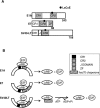APC/C and retinoblastoma interaction: cross-talk of retinoblastoma protein with the ubiquitin proteasome pathway
- PMID: 27402801
- PMCID: PMC5025812
- DOI: 10.1042/BSR20160152
APC/C and retinoblastoma interaction: cross-talk of retinoblastoma protein with the ubiquitin proteasome pathway
Abstract
The ubiquitin (Ub) ligase anaphase promoting complex/cyclosome (APC/C) and the tumour suppressor retinoblastoma protein (pRB) play key roles in cell cycle regulation. APC/C is a critical regulator of mitosis and G1-phase of the cell cycle whereas pRB keeps a check on proliferation by inhibiting transition to the S-phase. APC/C and pRB interact with each other via the co-activator of APC/C, FZR1, providing an alternative pathway of regulation of G1 to S transition by pRB using a post-translational mechanism. Both pRB and FZR1 have complex roles and are implicated not only in regulation of cell proliferation but also in differentiation, quiescence, apoptosis, maintenance of chromosomal integrity and metabolism. Both are also targeted by transforming viruses. We discuss recent advances in our understanding of the involvement of APC/C and pRB in cell cycle based decisions and how these insights will be useful for development of anti-cancer and anti-viral drugs.
Keywords: FZR1; LxCxE; anaphase promoting complex/cyclosome; cell cycle; human papilloma virus; retinoblastoma.
© 2016 The Author(s).
Figures



Similar articles
-
LxCxD motif of the APC/C coactivator subunit FZR1 is critical for interaction with the retinoblastoma protein.Exp Cell Res. 2021 Jul 15;404(2):112632. doi: 10.1016/j.yexcr.2021.112632. Epub 2021 May 8. Exp Cell Res. 2021. PMID: 33971196
-
Functional characterization of Anaphase Promoting Complex/Cyclosome (APC/C) E3 ubiquitin ligases in tumorigenesis.Biochim Biophys Acta. 2014 Apr;1845(2):277-93. doi: 10.1016/j.bbcan.2014.02.001. Epub 2014 Feb 22. Biochim Biophys Acta. 2014. PMID: 24569229 Free PMC article. Review.
-
Retinoblastoma protein and anaphase-promoting complex physically interact and functionally cooperate during cell-cycle exit.Nat Cell Biol. 2007 Feb;9(2):225-32. doi: 10.1038/ncb1532. Epub 2006 Dec 24. Nat Cell Biol. 2007. PMID: 17187060
-
Identification of the APC/C co-factor FZR1 as a novel therapeutic target for multiple myeloma.Oncotarget. 2016 Oct 25;7(43):70481-70493. doi: 10.18632/oncotarget.12026. Oncotarget. 2016. PMID: 27655696 Free PMC article.
-
APC/C ubiquitin ligase: Functions and mechanisms in tumorigenesis.Semin Cancer Biol. 2020 Dec;67(Pt 2):80-91. doi: 10.1016/j.semcancer.2020.03.001. Epub 2020 Mar 9. Semin Cancer Biol. 2020. PMID: 32165320 Free PMC article. Review.
Cited by
-
Pin1-Catalyzed Conformation Changes Regulate Protein Ubiquitination and Degradation.Cells. 2024 Apr 23;13(9):731. doi: 10.3390/cells13090731. Cells. 2024. PMID: 38727267 Free PMC article. Review.
-
Breast Cancer Patients: Who Would Benefit from Neoadjuvant Chemotherapies?Curr Oncol. 2022 Jul 12;29(7):4902-4913. doi: 10.3390/curroncol29070389. Curr Oncol. 2022. PMID: 35877249 Free PMC article. Review.
-
CDK4/6 inhibitors in breast cancer therapy: mechanisms of drug resistance and strategies for treatment.Front Pharmacol. 2025 May 12;16:1549520. doi: 10.3389/fphar.2025.1549520. eCollection 2025. Front Pharmacol. 2025. PMID: 40421216 Free PMC article. Review.
-
Progression after First-Line Cyclin-Dependent Kinase 4/6 Inhibitor Treatment: Analysis of Molecular Mechanisms and Clinical Data.Int J Mol Sci. 2023 Sep 22;24(19):14427. doi: 10.3390/ijms241914427. Int J Mol Sci. 2023. PMID: 37833875 Free PMC article. Review.
-
The Evolving Pathways of the Efficacy of and Resistance to CDK4/6 Inhibitors in Breast Cancer.Cancers (Basel). 2023 Oct 2;15(19):4835. doi: 10.3390/cancers15194835. Cancers (Basel). 2023. PMID: 37835528 Free PMC article. Review.
References
Publication types
MeSH terms
Substances
LinkOut - more resources
Full Text Sources
Other Literature Sources

